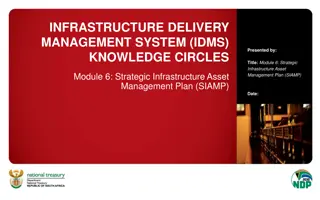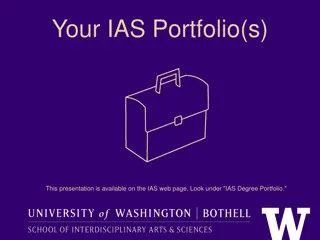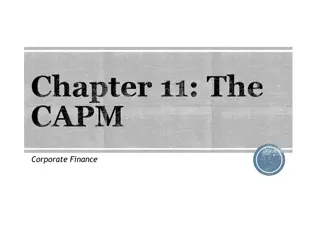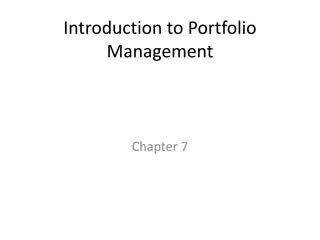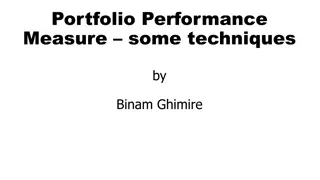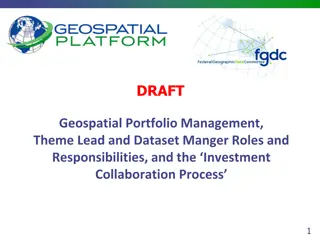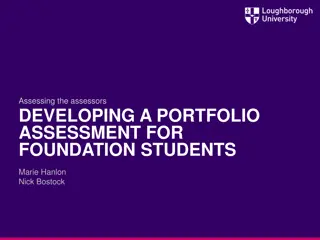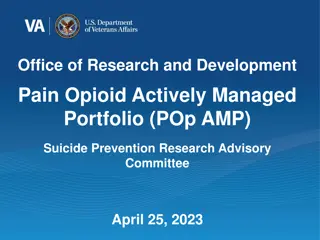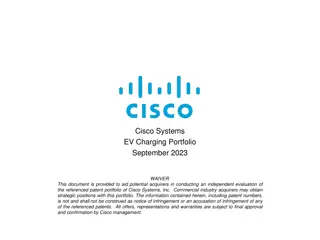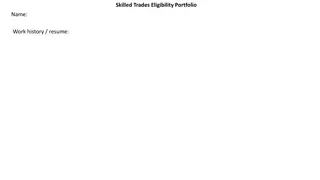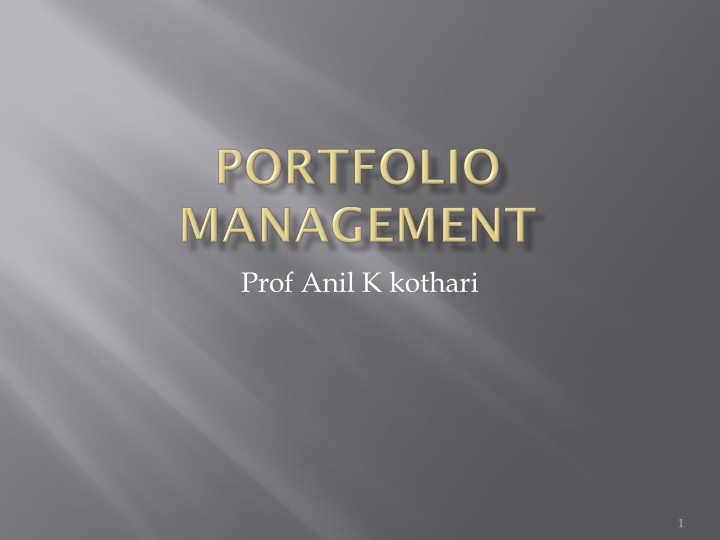
PORTFOLIO MANAGEMENT
Explore the Capital Asset Pricing Model (CAPM) developed by William Sharpe, which analyzes systematic and unsystematic risks in investments. Learn about the assumptions, relevance to portfolio risk, and the relationship between expected return and risk. Discover how CAPM measures the risk of a security in relation to a portfolio, based on the assumptions of risk-averse investors and maximizing terminal wealth utility.
Download Presentation

Please find below an Image/Link to download the presentation.
The content on the website is provided AS IS for your information and personal use only. It may not be sold, licensed, or shared on other websites without obtaining consent from the author. If you encounter any issues during the download, it is possible that the publisher has removed the file from their server.
You are allowed to download the files provided on this website for personal or commercial use, subject to the condition that they are used lawfully. All files are the property of their respective owners.
The content on the website is provided AS IS for your information and personal use only. It may not be sold, licensed, or shared on other websites without obtaining consent from the author.
E N D
Presentation Transcript
The capital asset pricing model was developed by the financial economist (and later, Nobel laureate in economics) William Sharpe, set out in his 1970 book Portfolio Theory and Capital Markets. His model starts with the idea that individual investment contains two types of risk: Systematic Risk vs. Unsystematic Risk 1.Systematic Risk These are market risks that is, general perils of investing that cannot be diversified away. 2. Interest rates, recessions, and wars are examples of systematic risks. 2.Unsystematic Risk Also known as "specific risk," this risk relates to individual stocks. In more technical terms, it represents the 3.component of a stock's return that is not correlated with general market moves. Modern portfolio theory shows that specific risk can be removed or at least mitigated through diversification of a portfolio. The trouble is that diversification still does not solve the problem of systematic risk; even a portfolio holding all the shares in the stock market can't eliminate that risk. Therefore, when calculating a deserved return, systematic risk is what most plagues investors. 2
The capital asset pricing model (CAPM) is the equation that describes the relationship between the expected return of a given security and systematic risk as measured by its beta coefficient. Besides risk the model considers the effect of risk-free interest rates and expected market return. Assumptions Basic assumptions of the CAPM model are as follows. Markets are ideal no transaction fees, taxes, inflation, or short selling restrictions. All investors are averse to risk. Markets are highly efficient. All investors have equal access to all available information. All investors can borrow and lend unlimited amounts under a risk-free rate. Beta coefficient is the only measure of risk. All assets are absolutely liquid and infinitely divided. The amount of available assets is fixed during a given period of time. Markets are in equilibrium. All investors are price takers, not price makers. Return of all available assets is subject to normal distribution function. 4
The Capital Asset Pricing Model (CAPM) measures the risk of a security in relation to the portfolio. It considers the required rate of return of a security in the light of its contribution to total portfolio risk. The CAPM holds that only undiversifiable risk is relevant to the determination of expected return on any asset. Even though the CAPM is competent to examine the risk and return of any capital asset such as individual security, an investment project or a portfolio asset 6
The CAPM is based on the following assumptions. 1. Risk-averse investors The investors are basically risk averse and diversification is necessary to reduce their risks. 2. Maximising the utility of terminal wealth An investor aims at maximizing the utility of his wealth rather than the wealth or return. The term Utility describes the differences in individual preferences. Each increment of wealth is enjoyed less than the last as each increment is less important in satisfying the basic needs of the individual. Thus, the diminishing marginal utility is most applicable to wealth. There are also other forms of utility functions. Some investors showing a preference for larger risks are those who have increasing marginal utility for wealth. In such cases, each increase in wealth prompts the individual to acquire more wealth. For a risk-neutral investor, each increment in wealth is equally attractive. In other words, each increment would have the same utility for him. 7
3. Choice on the basis of risk and return: Investors make investment decisions on the basis of risk and return. Risk and return are measured by the variance and the mean of the portfolio returns. CAPM assumes that the rational investors put away their diversifiable risk, namely, unsystematic risk. But only the systematic risk remains which varies with the Beta of the security. Some investors use the beta only to measure the risk while other investors use both beta and variance of returns as the sources of reward. As individuals have varying perceptions towards risk and reward, CAPM gives a series of efficient frontlines. 4. Similar expectations of risk and return All investors have similar expectations of risk and return. In other words, all investors estimates of risk and return are the same. When the expectations of the investors differ, the estimates of mean and variance lead to different forecasts. As a result, there will be innumerable efficient frontiers and the efficient portfolio of each will be different from that of the others. Varying preferences also imply that the price of an asset will be different for different investors. 5. Identical time horizon The CAPM is based on the assumption that all investors have identical time horizon. The core of this assumption is that investors buy all the assets in their portfolios at one point of time and sell them at some undefined but common point in future. This assumption further implies that investors form portfolios to achieve wealth at a single common terminal rate. 8
6. Free access to all available information One of the important assumptions of the CAPM is that investors have free access to all the available information at no cost. Supposing some investors alone are able to have access to special information which is not readily available to all, then the markets would not be regarded efficient. In other words, if the available information has not reached all, it will be difficult to draw a common efficient frontier line. 7. There is risk-free asset and there is no restriction on borrowing and lending at the risk free rate This is a very important assumption of the CAPM. The risk free asset is essential to simplify the complex pairwise covariance of Markowitz s theory. The risk free asset makes the curved efficient frontier of MPT to the linear efficient frontier of the CAPM simple. As a result, the investors will not concentrate on the characteristics of individual assets. By adding a portion of risk-free assets to the portfolio and borrowing the additional funds needed at a risk free rate, the risk is either decreased or increased. 8. There are no taxes and transaction costs According to Roll, there must be either a risk free asset or a portfolio of short sold securities. Then only the capital Market Line (CML) will be straight. When there are no risk free assets, the investor could not create a proxy risk free asset. As a result, the capital market line would not be linear and the direct linear relationship between risk and return would not exist. 9. Total availability of assets is fixed and assets are marketable and divisible This assumption holds the view that the total asset quantity is fixed and all assets are marketable. 9
Formula The CAPM model allows you to assess the expected return of a given security using the following formula: E(Ri) = RF+ i (E(RM) - RF) where E(Ri) is an expected return of a security, RFis a risk-free rate, iis the beta coefficient of a security, and E(RM) is an expected Market risk premium (RPM) can be calculated as follows. RPM) = E(RM) - RF The risk premium of a given security (RPi) can be assessed as follows:RPi) = i (E(RM) - RF) Example Let s assume an investor is thinking of buying one of three stocks: Stock A with a beta of 0.85, Stock B with a beta of 1.25, and Stock C with a beta of 1.65. If the risk- free rate is 4.50% and the expected market return is 12.35%, the expected return of each security can be assessed under CAPM. E(RA) = 4.50 + 0.85 (12.35 - 4.50) = 11.17% E(RB) = 4.50 + 0.85 (12.35 - 4.50) = 14.31% E(RC) = 4.50 + 0.85 (12.35 - 4.50) = 17.45% Thus, a relationship exists between risk and the expected return of a security. So, the higher the beta, the higher the expected return and vice versa. 10
CAPM's starting point is the risk-free ratetypically a 10-year government bond yield. A premium is added, one that equity investors demand as compensation for the extra risk they accrue. This equity market premium consists of the expected return from the market as a whole less the risk-free rate of return. The equity risk premium is multiplied by a coefficient that Sharpe called "beta." Beta's Role in CAPM According to CAPM, beta is the only relevant measure of a stock's risk. It measures a stock's relative volatility that is, it shows how much the price of a particular stock jumps up and down compared with how much the entire stock market jumps up and down. If a share price moves exactly in line with the market, then the stock's beta is 1. A stock with a beta of 1.5 would rise by 15% if the market rose by 10% and fall by 15% if the market fell by 10%. Beta, compared with the equity risk premium, shows the amount of compensation equity investors need for taking on additional risk. If the stock's beta is 2.0, the risk- free rate is 3%, and the market rate of return is 7%, the market's excess return is 4% (7% - 3%). Accordingly, the stock's excess return is 8% (2 x 4%, multiplying market return by the beta), and the stock's total required return is 11% (8% + 3%, the stock's excess return plus the risk-free rate). What the beta calculation shows is that a riskier investment should earn a premium over the risk-free rate. The amount over the risk-free rate is calculated by the equity market premium multiplied by its beta. In other words, it is possible, by knowing the individual parts of the CAPM, to gauge whether or not the current price of a stock is consistent with its likely return. 11
Portfolio diversification CAPM deals with the risks and returns on financial securities and defines them precisely, if arbitrarily. The rate of return an investor receives from buying a common stock and holding it for a given period of time is equal to the cash dividends received plus the capital gain (or minus the capital loss) during the holding period divided by the purchase price of the security. Although investors may expect a particular return when they buy a particular stock, they may be disappointed or pleasantly surprised, because fluctuations in stock prices result in fluctuating returns. Therefore common stocks are considered risky securities. (In contrast, because the returns on some securities, such as Treasury bills, do not differ from their expected returns, they are considered riskless securities.) Financial theory defines risk as the possibility that actual returns will deviate from expected returns, and the degree of potential fluctuation determines the degree of risk. An underpinning of CAPM is the observation that risky stocks can be combined so that the combination (the portfolio) is less risky than any of its components. Although such diversification is a familiar notion, it may be worthwhile to review the manner in which diversification reduces risk. 13
The security market line The culmination of the sequence of conceptual building blocks is CAPM s risk/expected return relationship. This fundamental result follows from the proposition that only systematic risk, measured by beta ( ), matters. Securities are priced such that: Rs= Rf+ risk premium Rs= Rf+ s(Rm Rf) Where: Rs= the stock s expected return (and the company s cost of equity capital). Rf= the risk-free rate. Rm= the expected return on the stock market as a whole. s= the stock s beta. This risk/expected return relationship is called the security market line (SML). I have illustrated it graphically in Exhibit III. As I indicated before, the expected return on a security generally equals the risk-free rate plus a risk premium. In CAPM the risk premium is measured as beta times the expected return on the market minus the risk- free rate. The risk premium of a security is a function of the risk premium on the market, Rm Rf, and varies directly with the level of beta. (No measure of unsystematic risk appears in the risk premium, of course, for in the world of CAPM diversification has eliminated it.) Security Market Line Slope The slope of the security market line represents the market risk premium, i.e. the excess return over the market return. The market risk premium compensates for the additional systematic risk associated with the security. Therefore, the higher the risk, the higher the market risk premium for the security, and the higher the expected overall return for the security. 14
In the freely competitive financial markets described by CAPM, no security can sell for long at prices low enough to yield more than its appropriate return on the SML. The security would then be very attractive compared with other securities of similar risk, and investors would bid its price up until its expected return fell to the appropriate position on the SML. Conversely, investors would sell off any stock selling at a price high enough to put its expected return below its appropriate position. The resulting reduction in price would continue until the stock s expected return rose to the level justified by its systematic risk. 15
Capital Market Line is a theoretical concept that represents all the portfolios that optimally combine the risk-free rate of return and the market portfolio of risky assets. Security Market Line measures the risk through beta, which helps to find the security s risk contribution to the portfolio. The differences between the capital market line and the security market line: Capital market line: CML shows the tradeoff between expected return and total risk. CML considers both systematic and unsystematic risk. CML is the graphical presentation of the equilibrium relationship between expected return and total risk for efficiency diversified portfolios. The slope of the CML shows the market price of risk for efficient portfolios. The CML is a line that is used to show the rates of return, which depends on risk-free rates of return and levels of risk for a specific portfolio. Slope of the CML = (Rm Rf) / m 16
Security market line: SML shows the tradeoff between the required rate of return and systematic risk. SML considers only systematic risk. SML is the graphical presentation of CAPM. The slope of the SML shows the differences between the required rate of return on the market index and the risk-free rate. SML is a graphical representation of the market s risk and returns at a given time. The slope of the SML = (Rm Rf). Most importantly, SML is used to determine whether more assets/investments can be added to the existing market portfolio. The risk running individually in these diverse market portfolios tells the investor about his undervalued and overvalued investments and thus this system of calculation is known as systematic risk. 17
Stock Beta Assume: RFR = 6% (0.06) RM = 12% (0.12) Implied market risk premium = 6% (0.06) RFR ) E(R i + = A B C D E 0.70 1.00 1.15 1.40 -0.30 i (R - RFR) M E(RA) = 0.06 + 0.70 (0.12-0.06) = 0.102 = 10.2% E(RB) = 0.06 + 1.00 (0.12-0.06) = 0.120 = 12.0% E(RC) = 0.06 + 1.15 (0.12-0.06) = 0.129 = 12.9% E(RD) = 0.06 + 1.40 (0.12-0.06) = 0.144 = 14.4% E(RE) = 0.06 + -0.30 (0.12-0.06) = 0.042 = 4.2% 18
Current Price Expected Dividend Expected Future Rate (Pi) Expected Price (Pt+1) (Dt+1) Stock of Return (Percent) A B C D E 25 40 33 64 50 27 42 39 65 54 0.50 0.50 1.00 1.10 0.00 10.0 % 6.2 21.2 3.3 8.0 19
Required Return Estimated Return E(Ri) Minus E(Ri) Stock Beta Estimated Return Evaluation A B C D E 0.70 1.00 1.15 1.40 -0.30 10.2% 12.0% 12.9% 14.4% 4.2% 10.0 6.2 21.2 3.3 8.0 -0.2 -5.8 8.3 -11.1 3.8 Properly Valued Overvalued Undervalued Overvalued Undervalued 20
Parameters of Comparison CML SML Full form Capital Market Line Security Market Line CML determines your average rate of success or loss in the market share. SML determines the market risk you are running with your investment. Definition Defines both functioning and non- functioning portfolios. Portfolios Defines functioning portfolios. Functioning More efficient. Less efficient. To describe only market portfolios and risk-free investments. Agenda To describe overall security factors. 21
The APT is a more flexible and complex alternative to the Capital Asset Pricing Model (CAPM). The theory provides investors and analysts with the opportunity to customize their research. However, it is more difficult to apply, as it takes a considerable amount of time to determine all the various factors that may influence the price of an asset. Assumptions in the Arbitrage Pricing Theory The Arbitrage Pricing Theory operates with a pricing model that factors in many sources of risk and uncertainty. Unlike the Capital Asset Pricing Model (CAPM), which only takes into account the single factor of the risk level of the overall market, the APT model looks at several macroeconomic factors that, according to the theory, determine the risk and return of the specific asset. These factors provide risk premiums for investors to consider because the factors carry systematic risk that cannot be eliminated by diversifying. The APT suggests that investors will diversify their portfolios, but that they will also choose their own individual profile of risk and returns based on the premiums and sensitivity of the macroeconomic risk factors. Risk- taking investors will exploit the differences in expected and real returns on the asset by using arbitrage. 22
Arbitrage in the APT The APT suggests that the returns on assets follow a linear pattern. An investor can leverage deviations in returns from the linear pattern using the arbitrage strategy. Arbitrage is the practice of the simultaneous purchase and sale of an asset on different exchanges, taking advantage of slight pricing discrepancies to lock in a risk-free profit for the trade. Mathematical Model of the APT The Arbitrage Pricing Theory can be expressed as a mathematical model: Where: ER(x) Expected return on asset Rf Riskless rate of return n(Beta) The asset s price sensitivity to factor RPn The risk premium associated with factor Historical returns on securities are analyzed with linear regression analysis against the macroeconomic factor to estimate beta coefficients for the arbitrage pricing theory formula 23
If thus the market index is used as a surrogate for other individual securities in the portfolio, the relation of any individual security with the Market index can be represented in a Regression line or characteristic line. This is drawn below, with the excess return on the security on the y-axis and excess return on the Market Portfolio on the x-axis. The equation of the characteristic line is Ri Rf = a + im (Rm Rf) + ei Ri is the holding period return on security i Rf is the riskless rate of interest Alpha is the vertical intercept on y-axis representing the return on the security when only unsystematic risk is considered and systematic risk is measured by Beta. ciis the residual component, not captured by the above variables. 25
Markowitz Model had serious practical limitations due to the rigours involved in compiling the expected returns, standard deviation, variance, covariance of each security to every other security in the portfolio. Sharpe Model has simplified this process by relating the return in a security to a single Market index. Firstly, this will theoretically reflect all well traded securities in the market. Secondly, it will reduce and simplify the work involved in compiling elaborate matrices of variances as between individual securities. 26
Rj= j+ jI+ ej Where jis some constant, say risk free return jis the Beta which is a risk measure of the market called systematic risk ADVERTISEMENTS: I is the value or return on the stock index. ejis the residual factor which cannot be specified. This optimal portfolio of Sharpe is called the Single Index Model. The optimal portfolio is directly related to the Beta. If Ri is expected return on stock i and Rf is Risk free Rate, then the excess return = Ri Rf This has to be adjusted to Bi, namely, Ri Rf/ iwhich is the equation for ranking Stocks in the order of their return adjusted for risk. The method involves selecting a cut-off rate for inclusion of securities in a portfolio. For this purpose, excess return to Beta ratio given above has to be calculated for each stock and rank them from highest to lowest. Then only those securities which have Ri Rf/ i, greater than cut-off point, fixed in advance can be selected. The basis for finding the cut-off Rate Ciis as follows: Basis for Cut-off Rate: For a portfolio of i stocks, Ci is given by cut-off rate- 27
https://www.economicsdiscussion.net/wp-content/uploads/2017/12/clip_image041_thumb2_thumb.jpghttps://www.economicsdiscussion.net/wp-content/uploads/2017/12/clip_image041_thumb2_thumb.jpg m2= variance in the market Index ADVERTISEMENTS: ei2= variance in the Stock movement in unsystematic Risk. Ri, Rf, Bi have the same meanings as referred to above. We have to see that for the optimum Ci that is C*, to be selected, the securities should have excess return to Betas above Ci. Excess return to Beta ratio should be above Ci to be included in the portfolio, to be precise. This Ciis that point which shows the cut-off point among those excess returns to Beta ratios. 28
The calculation of C requires data, which are shown below: Rf = Risk free Return = 5% Based on the above data, we have to calculate the C values for each security for inclusion in the optimum portfolio. The following table gives the example: 29
All securities with excess return to Beta ratio above the cut-off rate C*, say 3.0 in the above table will be chosen in the portfolio. The calculation of cut-off point is also explained. In arriving at the optimal portfolio, the emphasis of Sharpe Model is on Beta and on the Market Index. Sharpe s optimal portfolio would thus consist of those securities only which have excess return to Beta ratio above a cut-off point. By this method, selection of the portfolio has become easier due to the ranking of the securities in the order of their excess return and applying the yardstick of a required cut-off point for selection of securities. That cut-off point is related to the excess return to Beta ratio on the one hand and variance of the market index m2and variance of the stock s movement which is related to the unsystematic risk, namely, ei2. It is thus seen that Sharpe s Portfolio takes into account both the systematic market related risk and unsystematic risk and residual risk. 31
The percentage to be invested in each security is- The second expression in the bracket will determine the proportion of funds to be invested in each security. The first expression simply scales the weight on each security, so that the total is summing upto 1. 32
Portfolio Risk: When two or more securities or assets are combined in a portfolio, their covariance or interactive risk is to be considered. Thus, if the returns on two assets move together, their covariance is positive and the risk is more on such portfolios. If on the other hand, the returns move independently or in opposite directions, the covariance is negative and the risk in total will be lower. Mathematically, the covariance is defined as- 33
o choose the best portfolio from a number of possible portfolios, each with different return and risk, two separate decisions are to be made, det Determination of a set of efficient portfolios. Selection of the best portfolio out of the efficient set. 34
Efficient frontier and Capital Market Line (CML) An efficient portfolio is one that produces the highest expected return for any given level of risk. Markowitz showed how to find the frontier of risk and returns for stocks. Only portfolios on the frontier are efficient. Sharpe added the riskless asset return and noted that returns on a line connecting rrfand the tangency point on the efficient frontier was also feasible in the sense that portfolios consisting of some of the riskless asset and some of the market portfolio could be developed. The introduction of a risk-free asset in the portfolio changes the Markowitz efficient frontier into a straight line. He called that straight efficient frontier line the Capital Market Line (CML), and he used indifference curves to show how investors with different degrees of risk aversion would choose portfolios with different mixes of stocks and the riskless asset. Investors who are not at all averse to risk could borrow and buy stocks on margin, and thus move out the CML beyond the tangency point. Since the line is straight, the math implies that any two assets falling on this line will be perfectly positively correlated with each other. 35
Determining the efficient set A portfolio that gives maximum return for a given risk, or minimum risk for given return is an efficient portfolio. Thus, portfolios are selected as follows: (a) From the portfolios that have the same return, the investor will prefer the portfolio with lower risk, and (b) From the portfolios that have the same risk level, an investor will prefer the portfolio with higher rate of return. 37
As the investor is rational, they would like to have higher return. And as they are risk averse, they want to have lower risk. In Figure 1, the shaded area PVWP includes all the possible securities an investor can invest in. The efficient portfolios are the ones that lie on the boundary of PQVW. For example, at risk level x2, there are three portfolios S, T, U. But portfolio S is called the efficient portfolio as it has the highest return, y2, compared to T and U[needs dot]. All the portfolios that lie on the boundary of PQVW are efficient portfolios for a given risk level. 38
The boundary PQVW is called the Efficient Frontier. All portfolios that lie below the Efficient Frontier are not good enough because the return would be lower for the given risk. Portfolios that lie to the right of the Efficient Frontier would not be good enough, as there is higher risk for a given rate of return. All portfolios lying on the boundary of PQVW are called Efficient Portfolios. The Efficient Frontier is the same for all investors, as all investors want maximum return with the lowest possible risk and they are risk averse. 39
Figure 2 shows the risk- return indifference curve for the investors. Indifference curves C1, C2and C3are shown. Each of the different points on a particular indifference curve shows a different combination of risk and return, which provide the same satisfaction to the investors. Each curve to the left represents higher utility or satisfaction. The goal of the investor would be to maximize their satisfaction by moving to a curve that is higher. An investor might have satisfaction represented by C2, but if their satisfaction/utility increases, the investor then moves to curve C3Thus, at any point of time, an investor will be indifferent between combinations S1and S2, or S5and S6. 40
The investor's optimal portfolio is found at the point of tangency of the efficient frontier with the indifference curve. This point marks the highest level of satisfaction the investor can obtain. 41
This is shown in Figure 3. R is the point where the efficient frontier is tangent to indifference curve C3, and is also an efficient portfolio. With this portfolio, the investor will get highest satisfaction as well as best risk-return combination (a portfolio that provides the highest possible return for a given amount of risk). Any other portfolio, say X, isn't the optimal portfolio even though it lies on the same indifference curve as it is outside the feasible portfolio available in the market. Portfolio Y is also not optimal as it does not lie on the best feasible indifference curve, even though it is a feasible market portfolio. Another investor having other sets of indifference curves might have some different portfolio The investor's optimal portfolio is found at the point of tangency of the efficient frontier with the indifference curve. This point marks the highest level of satisfaction the investor can obtain. 42
This Exhibit demonstrates that it is possible to eliminate risk that is, to achieve zero variance with a portfolio of two perfectly positively correlated stocks. To do this, it is necessary to be long in one investment and short in the other in proportions that place the portfolio at point C. 47
with perfect positive correlation, the standard deviation of a portfolio with positive weights on both stocks equals the portfolio-weighted average of the two standard deviations. Now, consider the case where risky investments have less than perfect correlation (p < 1).The states that the lower the correlation, the lower the portfolio variance. Therefore, the standard deviation of a portfolio with positive weights on both stocks is less than the portfolio-weighted average of the two standard deviations, which gives the curvature to the left shown in Exhibit 4.5. The degree to which this curvature occurs depends on the correlation between the returns. Consistent with Result 4.2, the smaller the correlation, p, the more distended the curvature. The ultimate in curvature is the pair of lines generated with perfect negative correlation, p = -1, which is the smallest correlation possible. 48
An optimal stock portfolio refers to a stock portfolio that incorporates the stocks configured in such a manner that they yield the optimal return statistically possible at a given level of risk accepted by an investor. The modern portfolio theory stresses on the optimal portfolio concept by assuming that the investors try to minimize risk obsessively while looking for the highest return possible. As per this theory, investors should make rational decisions for achieving maximum returns at their acceptable level of risk. The working of the optimal portfolio can be easily understood by looking at the chart below. The optimal-risk portfolio is generally found in the middle of the curve. If one goes further higher up the curve, it will mean taking more risk proportionately for achieving lower incremental return. Similarly if one goes at lower end of the curve, it will mean low risk/low return portfolios. 49



